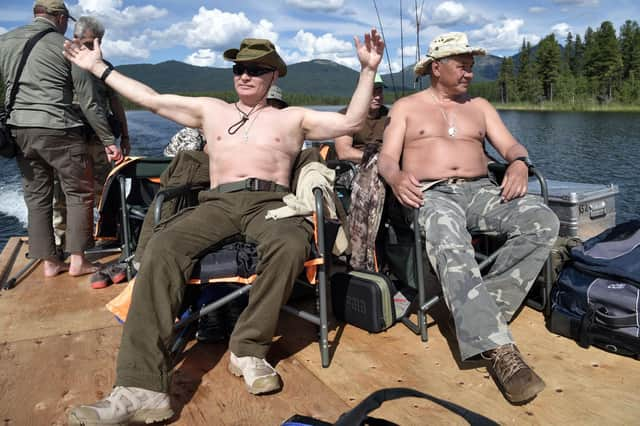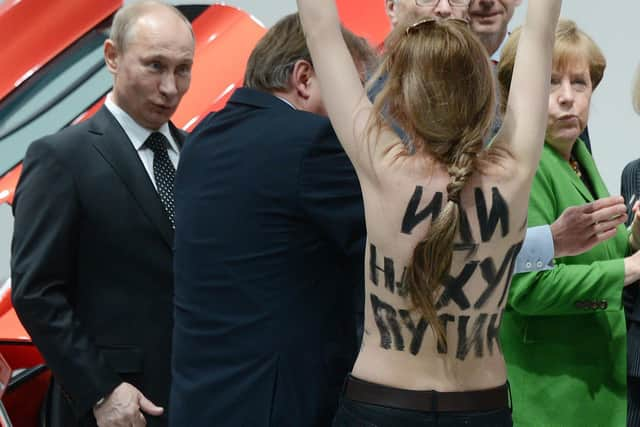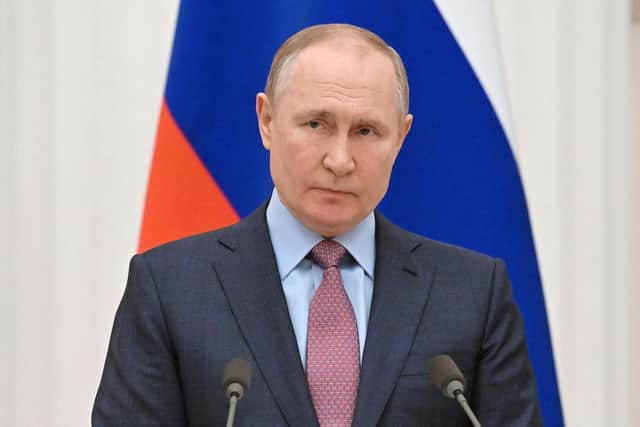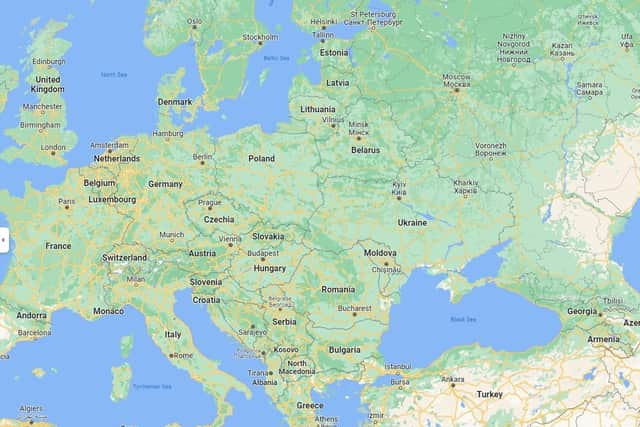Vladimir Putin: the story behind the real Russian President and former NATO chief reveals secret to stopping him


Who is Vladimir Putin and what are his hobbies?
With a background as an intelligence officer working for the KGB - including time spent inside East Germany - the now Russian President retired from operational intelligence gathering service in 1990 after 16 years.
After winning the confidence of Russian President Boris Yeltsin, Putin was quickly identified as a likely successor, his steely-eyed ice cold decision making ability setting him out from other would-be candidates.
Advertisement
Hide AdAdvertisement
Hide AdPutin was made acting President during the final hours of 1999. He went on to win the 2000 election, and assumed control and power. He has been in power ever since, as President (1999 - 2008 & 2012 - present day) and Prime Minister (2008 - 2012).
Putin has two children. He is divorced.
To go with his strong-man style of national leadership, he enjoys exercise, particularly martial arts - he has a black belt in judo. He is also an animal lover, surrounding himself with dogs and horses - though he also likes to kill animals for sport; a hunting enthusiast often pictured wielding high-powered hunting rifles, occasionally shirtless on horseback!
His morning routine involves a long swim - where he claims to do much of Russia's thinking - a gym session and a late breakfast. Born in October 1952, he is currently 69 years old.


Why is Russia invading Ukraine?
The answer is both simple and complex: in simple terms, Ukraine is where East meets West - a crucible of geo-political tension. Democracy meets dictatorship. A bridge from Soviet command and conquer centralism to a pluralist, democratic horizon: opportunity versus oppression. At least, in theory.
Advertisement
Hide AdAdvertisement
Hide AdTensions between the two nations fizzed in 2014 when Russian troops were sent to overrun Ukrainian forces, annex Crimea, run unilateral referenda and ultimately attempt to force the UN Security Council to recognise its faux election - one where the result indicated almost every Ukrainian in Ukraine wanted to be Russian. The UN Security Council did not accept that. Instead, a collective envoy - Russian and American - negotiated a series of agreements that resulted - officially at least - in a ceasefire. It is now known as the Minsk Agreement (Protocol).
Ever since coming to power, Putin has sought to control everything from the centre. A dictatorial style of nationhood that requires State-enforced compliance, he quickly dissolved Russia's 89 regions into seven states (districts) that would be easier to observe, run and hold accountable in terms of their leadership and their forthcoming compliance - or otherwise. Putin appointed district commanders personally.


But, in truth, Ukraine has never wanted to dance to Russia's tune. In 1991, Ukraine declared itself independent, and set about electing its own President. By the end of the 1990s - despite significant challenges around corruption - Ukraine had its own currency and a relatively stable economy to call its own, too.
And this is where Russian paranoia begins to be explained: Ukraine is a large country. As well as borders with Russia, it shares borders with Belarus, Moldova, Lithuania, Poland, Romania, Slovakia and Hungary. It has also, increasingly, shared ambitions with some of its more progressive neighbouring democracies and it is those admiring glances to the West that causes tensions. Unhelpfully, for Ukraine at least, in terms of exposure to marine attacks, it also borders onto the Black Sea.
Advertisement
Hide AdAdvertisement
Hide AdEver since Ukraine committed to full nuclear disarmament in the 1990s, it has sought alliances and reassurances from its friends in the West over so-called friends in the East. Effectively seeking European allegiance over Russian. In short, Ukrainians want a peaceful, democratic, progressive and developed landscape; one where their destiny is a pro-choice one, not an enforced military one.
This is where NATO - North Atlantic Treaty Organisation - comes in because as Ukraine sees it, should they be able to join NATO, it would benefit from the full force of military might that comes with that - effectively putting more distance between it and Russia. At the time the Minsk Agreement was signed, Ukraine set itself the target of European Union membership by 2020.


What is NATO and why doesn't Russia want Ukraine to join
NATO: North Atlantic Treaty Organisation - in a nutshell, NATO was created in 1949 precisely to guard against Russian (Soviet Union) military might and aggression. Should Ukraine join NATO, Putin would not be able to invade without NATO responding in its entirety. All for one, one for all.
Post World War 2, the United States recognised that its safety and security would be better served should Russia's neighbouring countries stand united against possible Russian threats. And so NATO was formed. The United States, Canada, Belgium, Denmark, France, Iceland, Italy, Luxemburg, the Netherlands, Norway, Portugal, and the United Kingdom were the founder members. The Germans joined in 1955. The Spanish in 1982.
Advertisement
Hide AdAdvertisement
Hide AdNATO now comprises 30 countries: ALBANIA - BELGIUM - BULGARIA - CANADA - CROATIA - CZECH REPUBLIC - DENMARK - ESTONIA - FRANCE - GERMANY - GREECE - HUNGARY - ICELAND - ITALY - LATVIA - LITHUANIA - LUXEMBOURG - MONTENEGRO - NETHERLANDS - NORTH MACEDONIA - NORWAY - POLAND - PORTUGAL - ROMANIA - SLOVAKIA - SLOVENIA - SPAIN - TURKEY - UNITED KINGDOM - UNITED STATES.
If Ukraine were to make it 31, those nations would collectively defend the territory of Ukraine as one against Russian attacks, hence Putin's determination to seize control of Ukraine, or obtain guarantees from the international community that Ukraine will never join NATO - a reassurance that Ukraine, and the international community, appear unwilling to offer.
Ukraine and Russia at war: what is happening now?
In short, Putin's Russia has begun its invasion of Ukraine. Military experts estimate some 150-200,000 Russian troops deployed around the Ukraine border, adopting strategic positions. To all intents and purposes, Putin and Russia are ready to trigger a full-scale invasion - one that will inevitably lead to bloodshed and loss of life not seen in Europe since the Second World War. Open source satellite images show the full scale of what could happen should Putin give his generals the go-ahead, with hardware in position.
Sanctions, sanctions and more sanctions: the secret to seizing Putin's power?In an essay written exclusively for The Yorkshire Post, David Hobbs - former Secretary General of the NATO Parliamentary Assembly and current CEO of the Atlantic Treaty Association of the United Kingdom says that, yes, in the short term multiple sanctions by multiple nations - including flushing London clean of Russian money - is key. Germany has already halted Nord Stream 2 - a multi-billion-Euro gas network investment that would have pumped energy the way of Europe and Euros the way of Russia.
Advertisement
Hide AdAdvertisement
Hide AdBut long term he says that climate consciousness - the race to carbon neutrality - is as much about saving the planet from pollution, emmissions and the natural disasters brought on by climate change as it is about weaning the West off Russian gas and fossil fuels, thereby starving Putin - and future Russian commanders-in-chief - of the resources they need to maintain their military threat to those around them and others around the world.
You can read Mr Hobbs' essay in full, HERE.
Comment Guidelines
National World encourages reader discussion on our stories. User feedback, insights and back-and-forth exchanges add a rich layer of context to reporting. Please review our Community Guidelines before commenting.